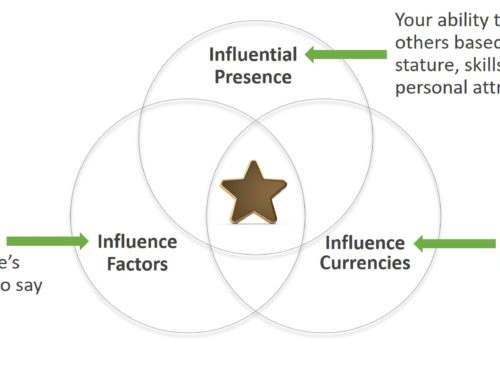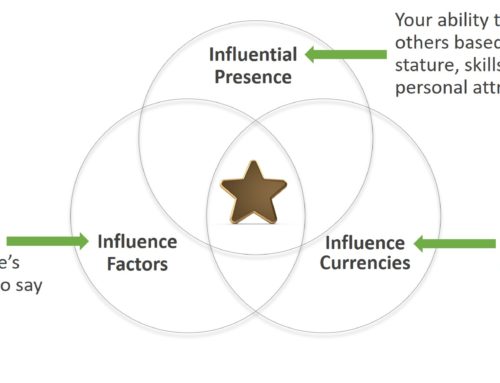Sometimes it is not what you say, it is how you say it, when you say it, where you say it, and/or the process you use to say it.
There are different techniques you can use in a seemingly ordinary conversation that dramatically enhance your ability to influence others. Your goal when experimenting with these techniques is to internalize them through practice, so using them does not seem calculated, disingenuous, or opportunistic.
The beauty of these techniques, in addition to their general applicability as an influence-based tactic, is that they are easily incorporated into other types of interactions, such as negotiation, conflict resolution, delegation, vendor management, and other IT-related activities.
While reading this blog, you should consider the following questions:
- Which techniques do I like most and want to incorporate into my personal conversational repertoire?
- How do others use these techniques on me, and why do they work?
- How can I use these tactics in other interpersonal communications like negotiation and conflict resolution to increase my effectiveness?
- Which tactics that I have observed others using would I like to use?
1. Storytelling
Using stories to convey information, maintain historical records, influence others, and perpetuate cultures, religions, and family identities is as old as humanity itself. Humans are internally wired to enjoy stories. Don’t children want a bedtime story before going to sleep? Storytelling was the primary vehicle for passing information from generation to generation for a very long time.
Politicians often begin speeches by defining their accomplishments in terms of facts and figures. Then they try to humanize these accomplishments by telling a story about a specific individual, group, or municipality that benefited from their actions.
Storytelling, when done correctly, is so memorable because it brings together information, settings, actions, emotions, and other factors that stimulate different parts of the brain. As an example, have you ever said to yourself or others, “I don’t remember what the speaker said, but I remember how they made me feel”?
As an IT professional, you can use storytelling as a tool to help get your projects approved by describing the current state of a situation and your vision that the project will fix in the form a story, rather than simply with facts and figures.
Many books have been written on storytelling. I suggest you study this topic via books, classes, YouTube videos, or other sources. When trying to influence others, storytelling will be of great value to you, and you will most likely have a little fun in the process.
2. Purposeful Questions
Asking the right type of question at the right time has great value, particularly if it is asked with a specific outcome in mind. The following purposeful question types allow you to lead individuals down a road they believe they are navigating.
These questions work so well because you are not telling people what to do; you are gently guiding them with the question in the direction you desire. Their internal thought process allows them to feel like they made the decision to move in the direction you desired. This makes it their idea, not yours.
Leading Questions
A leading question is posed with the intent of soliciting a specific outcome or action. For example, when a salesperson asks, “Do you have any more questions about the product before we start the paperwork?” what they mean is, “Okay, you have asked enough questions; let’s sign the contract and move forward.”
Other leading questions include:
- Do you agree that we should upgrade the version of the software?
- Which one of your subject matter experts will be assigned to advise on the project?
- Isn’t this a great project plan?
- Would our rather give us funding to update our infrastructure or enhance data security?
Descriptive Questions
The descriptive question provides information within the question. Using this type of question provides the advantage of telling people something without sounding pushy, disrespectful, self-serving, or boastful. In effect, you are sending a subliminal message in the form of a question.
For example, saying, “Our product has a really nice new video option. Have you tried it yet?” This example sounds friendly and inquisitive, and it contains a statement about your product combined with a leading question.
Other descriptive questions include:
- Did you hear about how great the great look of our new software app?. Do you want to see it?
- We have a very comprehensive data set. Do you think it would be worthwhile to try using predictive analytics as part of our next marketing plan?
Conversation Control Questions
This type of question is designed to gain permission to take control of the conversation. This question type can be used by many professions and in many circumstances. Business analysts, researchers, doctors, technical support personnel, and others can use this technique as a way to begin collecting the information needed to complete their task.
I personally use this type of question in two ways. First, when interviewing people for my blog, the conversation generally begins with the normal pleasantries, but at some point, the interview must start. Then I ask, “Is it okay with you if I go into interview mode and ask you a bunch of questions?” The answer is virtually always “Yes,” and the interview begins. A second way I like to use this question type is to collect information for a custom class or keynote speech I am preparing for a client. I will ask, “May I ask you lots of questions to better understand your requirements and the audience’s needs and interests?”
Other conversation control questions include:
- “I’m going to ask you a series of questions, okay?”
- “I can help you best if we stay on topic, agreed?”
3. Direct Request
Sometimes, the best way to influence someone is simply to ask for what you want directly. Examples of this in the workplace include:
- Would you please reply immediately to my email? I have a tight deadline.
- Could I please ask you for a favor?
- Would you please approve my project? I’ll be happy to review the details first if you wish.
This direct method can work easily if you warm up the person first by subtly using another influence technique or two before “the ask.”
As an example, let’s say you want to ask Jessie to approve your project. First, find a way to do Jessie a small favor of some type. This creates a sense of obligation.
Alternatively, before asking Jessie, you could get a few other people to approve your project; ideally, people whom Jessie respects. This allows you to use three influence techniques simultaneously:
- Social proof (safety in numbers), because other people have signed it.
- Authority, because Jessie respects those who have already signed it.
Liking, because if Jessie likes the other people who signed it, it’s likely Jessie will want to go along with them.




